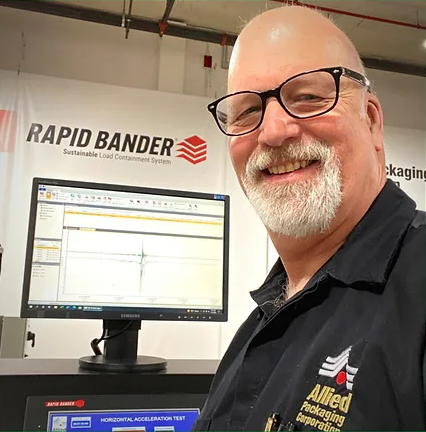Ask Steve
April 14, 2022
Question from Fred: What is the optimum number of inches that you should wrap on the pallet itself to best secure the load to the pallet and not be damaged by forklift tearing film?
Hi Fred,
The key to optimal containment is to unitize the load with stretch film so there is little to no movement of the load components or shift between the layers during shipment. Why is this important? If the load is not well unitized, and if the bottom layer of the load is bound to the pallet so it does not move, any applied force to the side of the load will cause significant shifting between the layers allowing the load to “lean” to one side. This will eventually cause the supporting packages at the bottom of the leading edge to collapse, scattering the contents in the trailer. A properly unitized load will not collapse even if it shifts off the pallet. In my view, from a product loss standpoint, unitizing the load is more critical than tying it to the pallet, based on the extensive testing we have done here in our lab.
Once we have a configuration that properly contains the load, the next challenge is how to tie it to the pallet. The ideal situation is to have the load footprint the same as that of the pallet. (Probably not going to happen though…) The greater the distance from the edge of the pallet to the load, the greater the challenge because the film is stretched more (and applies more force) around the pallet than it does to the load (it is stretched less at the load). Also, as the film is stretched, it thins out and stiffens, so it is far more prone to web breaks, especially at the sharp corners of the pallet. Conventional practice is to apply more wraps at the bottom using less tension to help tie the load to the pallet without breaking the web.
Now that we have a better understanding of load containment fundamentals, let’s answer your question. You only need as much overlap on the pallet as necessary to grip it effectively, normally 2” to 2- 1/2” at most. Any more than that will not provide additional benefit, and if the stretch film extends the all the way to the bottom of the pallet, it will get pierced by the forks when the pallet is moved. In other words, besides perhaps making you feel better, more overlap doesn’t contribute to load containment.
Pallet condition is an absolute key to effectively securing the load to the pallet. If deck boards are missing, or splintered, there is nothing for the film to grip. When a force is applied to the side of the load during shipment, the film will simply pull up from the pallet stringers until it pops free. In addition, sharp corners will break the web during wrapping. So, it’s worth saying again, the condition of the deck boards is the most critical element. We understand that pallet condition is something that you may not have control over, therefore, we have an alternative to applying a ton of film on the pallet to compensate. The reinforcement filaments or bands in our Rapid Bander system effectively grip and “lock” the bottom wraps to the pallet with a minimum application of film. When a sharp corner or splinter punctures the film, it does not break the web, only tears to the next band and stops. So, you don’t have to reduce tension and give up containment to tie the load to the pallet using Rapid Bander.
In summary, we have learned: a) unitizing the load is more important that tying it to the pallet; b) deck board condition is key to the film properly “gripping the pallet; and finally, c) you don’t need any more than a couple of inches of film overlap on the pallet.
Thanks for asking!








